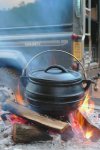

My copy of an 18th century brass trade kettle. I could not find an exact copy of an original, so I bought one & cut it down to size & made & fitted the correct bail lugs. The finished product is what you see above.

The kettle & the wooden spoon is all I carry for cooking, I have my knives of course, & a pointy stick for cooking meat is easily fashioned on site. My youngest son made this spoon for me, his first attempt. I think he did a pretty good job, I love it
Keith.






